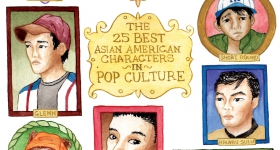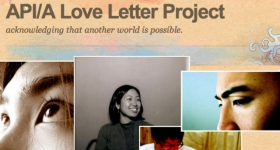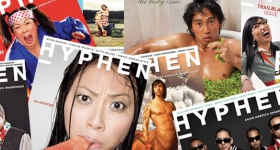I admit it: I'm picky about my Chinese food. A few things make me wary - seeing mostly white customers - and a "chinky font" proudly displayed on the sign. These tip-offs tell me that the food is no good or overpriced and bring flashbacks of "Yellow Peril" villains like Fu Manchu. It's like a bang on the head by the exotic wise old Chinese sage, courtesy of Hollywood, or the surefire "Where are you from?" question.
So who is responsible for this faux Chinese lettering that leaves me cringing?
An initial search on the Internet for a Chinese font actually leads me to what the first-generation kids in my family call the Chinese Chinese - or the "real Chinese" Chinese characters. It takes me a few tries with words like "oriental" and "chink" and other stereotypical guesses to find what I'm looking for - that telltale thick triangle lettering signaling fortune cookies or some inauthentic hole-in-the-wall.
"The Foreign Look" section of Websites like www.fontstock.net offer free downloads of fonts like Wonton, Chinese Takeaway, Fu Manchu, Takeout, Shanghai and Chow Fun. Even the Olympics in Beijing host a font that looks suspiciously close to these.
I seem to be getting somewhere when I discover typophile.com, a Website for all things typeface related, where there have been conversations about faux Chinese lettering as well as articles interrogating the authenticity and usefulness of "ethnic" fonts like the Sombrero, Hot Tamale and the Neuland, which is a font that signals "African-ness" and "African American-ness."
Though there is debate among the Typophiles about the origins of these fonts, there is agreement that these fonts are not "authentic."
One user on Typophile speculates that the first faux-lettering was a direct result of Chinoiserie, the craze for the "Orientalesque" in European arts in the 17th and 18th centuries. According to Edward Said, author of Orientalism, this type of tradition highlighted prejudiced interpretations of Eastern culture and people, shaped by European imperialism. Another Typophile user suggests that the lettering arose from an attempt at imitating a stroke of a Chinese painting of a section of bamboo.
User Kent Lew posts: "The 1925 BB&S (Barnhart Brothers & Spindler) catalog shows three faces called Japanet, Pekin and Bamboo. None of them is truly oriental, but seem to evoke an Eastern exoticism." Each is supposedly designed in the late 1800s but marketed under non-"oriental" names like Wedge, Gothic, Dormer and Freak.
I make friends with Mike Yanega, who runs Bowfin Printworks, a one-man layout design service specializing in personalized stationery products. A retired engineer who began designing fonts on his dot-matrix printer in 1982 with his Atari computer, Yanega is known for helping people identify fonts for free.
According to Yanega, a font called Wonton looks like it was modeled after a "Chinatown" typeface found in the Solotype Catalog, a large sourcebook of fonts gathered by font devotee Dan X. Solo, along with Mandarin, Cathay, Chopstick, Shanghai, Fantan, Pekin, Susie Wong and Hong Kong.
Yanega points to the immigration and importation of large numbers of Chinese workers into the United States during the westward expansion of the railroads as a possible starting point for the origin of these fonts.
"The earliest uses for such typefaces would be after the time that Americans began to have an interest in Chinese goods, food and services," Yanega says in an email interview. "Today this style of type is a cliché, but it was a novelty once, that was probably intended to play on new interest in things related to China."
I ask about Image Club Graphics, a Canadian software company that Yanega attributes Wonton to in his font identification guide.
He dismisses the font as the result of a company capitalizing on a way to make money. "My sense is that they are a somewhat silly commercial invention and are not taken very seriously as anything more than marketing display faces."
Is it all about the marketing? I ask a friend whose family runs a Chinese restaurant in Lincoln, MA, which uses the font for its sign and menu.
"They use that particular font because it's unique and attracts attention," she tells me. "Businesses that have been around were using that and other businesses that came on later probably copied the font because it was commonly used back then so people kept on reusing it because that's what the norm was."
"You should ask the people who made the signs," my father suggests. His sister runs a Chinese restaurant, but he doesn't want me to bother her with my silly questions. "She doesn't remember why she uses the font. It was probably suggested to her by them."
Both those conversations re- mind me that it's probably not that important to those who are doing all the work it takes to keep a restau- rant going - like cook- ing the food or paying the bills - as to why such a ste- reotypical font is showing up in their windows or on their awning. I have a memory of my friend Saba and me, both of us newly minted Asian American 16-year-old activists, marching up to a Boston Chinatown restaurant with the sign "oriental food" painted outside in stereotypical faux Chinese lettering, of course.
"We don't like the word 'oriental',"! muttered to the takeout lady, who asked us to repeat ourselves.
"It's for rugs, not people," Saba added expectantly. But the lady was busy stuffing boxes and wooden chopsticks into bags and gave up trying to make sense of our odd comments. We trudged back out into the night, feeling sheepish for bothering her at work. - Ching-In Chen










Comments